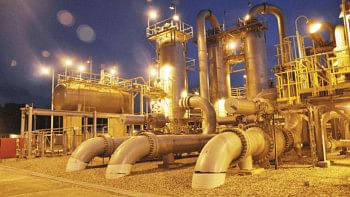Boro harvest in full swing in haors

Farmers in Netrakona's haor areas have started harvesting Boro paddy ahead of the Bangla month of Baishakh, fearing possible inclement weather in the coming days, including rainfall and nor'westers.
This year, early-ripening Boro varieties were cultivated in the 134 small and large haors of the district, particularly in Madan, Mohanganj, and Khaliajuri upazilas.
The new varieties have matured earlier than those used last year, prompting farmers to begin harvesting sooner.
Hundreds of farmers were seen busy harvesting paddy yesterday in Dingapota and Jagannathpur haors in Mohanganj and Khaliajuri upazilas.
Netrakona, known as a hub for Boro cultivation, relies heavily on its haor areas, which comprise about 25 percent of the district's arable land and supports the livelihoods of nearly 30 percent of its population.
According to the Department of Agricultural Extension (DAE), Boro paddy has been cultivated on 1,85,460 hectares this year, including 41,075 hectares in haor areas. If the weather remains favourable, all the paddy in the haors can be harvested within the next 10 days.
"The weather has been good this year. The new varieties are also more disease-resistant. So, the yield seems higher. Now all we need is a good market price," said Abdul Kaiyum Khan, a farmer from the Dingapota Haor area.
Md Abdus Sakur Sadi, agriculture officer of Mohanganj upazila, said they encouraged farmers to plant high-yielding, pest and disease-resistant varieties such as BRRI Dhan-88, 89, 92, 96, 102, and BINA-25, which mature faster than the commonly used BRRI Dhan-29. "Farmers followed our advice, and we expect a bumper yield," he added.
The Bangladesh Meteorological Department has warned that although rainfall is currently low, heavy rain of over 250mm is likely in border areas after April 17.
Md Nuruzzaman, deputy director of DAE in Netrokona, said, "Our production target this year is 12,62,000 tonnes, worth over Tk 3,155 crore at government-declared prices."

 For all latest news, follow The Daily Star's Google News channel.
For all latest news, follow The Daily Star's Google News channel. 



Comments